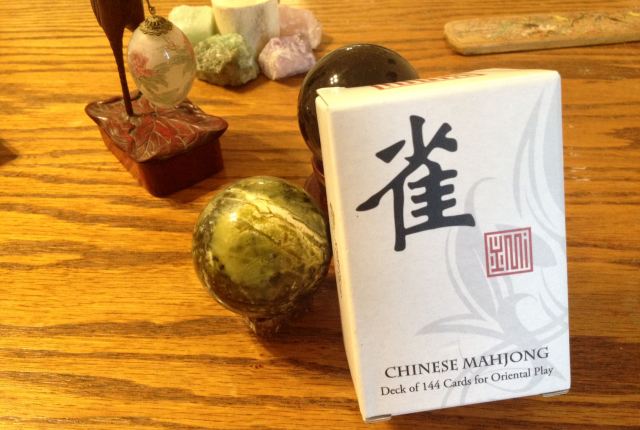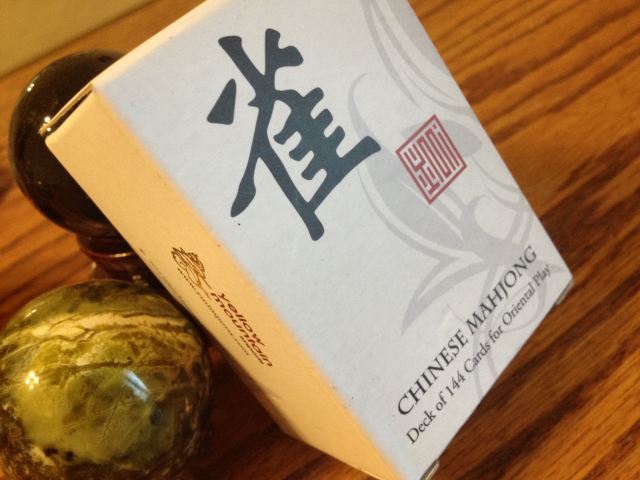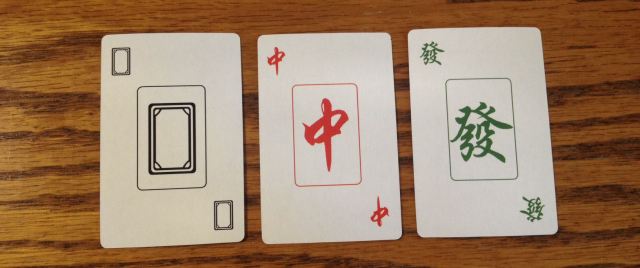
While there is no historical verification that tarot descended from mahjong, their striking similarity in structure and the cosmological or philosophical correspondences associated with the playing pieces is still worth noting. Both seem to be subdivided into Trump cards and Minors, and within the Minors, further subdivisions into suits, with each suit numbered into pip cards or tiles. Both were intended for games, but both are also used for divination.
Recently I’ve been inspired to hunt down my own mahjong set, but there is a reason Chinese people get special tables for mahjong– the darn thing takes up a lot of space. There’s just a crap ton of tiles that make annoying clicking sounds when you shuffle, and the tiles remind me of Joy Luck Club or something, I don’t know. I knew I wouldn’t be using my set for games, and it’d be strictly for divination study. Intuitively, a whole set of mahjong tiles (the standard click-clack ones Chinese folk play with) didn’t feel right in my reading room, my personal sacred space. So. I opted for a more discrete alternative– mahjong in the form of cards. They have that now! It’s awesome. It’s a deck of 144 cards.

I’m using a cute little deck referred to simply as “Chinese Mahjong: Deck of 144 Cards for Oriental Play” published by Yellow Mountain Imports. You can get it off Amazon for all of five bucks. It’s great. The card quality is kind of meh. They didn’t produce this particular deck with esoteric or spiritual work in mind, that’s for sure. There’s a tacky high-gloss laminate and as you can see from the photos, it’s very, very basic in card imagery.



Mahjong consists of 3 suits: Wheels, Bamboo, and Characters. The 3 suits are correspondent with Heaven, Earth, and Man, after the Chinese cosmological concept of the Trinity of Lucks.
Heaven Luck represents circumstances you’re born into, beyond your control, like the social class of your parents or innate talents and physical attributes, i.e. nature. Heaven Luck is believed to be pre-ordained.
Earth Luck is your geographical location, and how where you are affects what you do or who you become, i.e., nurture. Earth Luck is your environment and how your environment helps or hinders your success.
Man Luck is free will, what you do with yourself, the choices you make, your education, your actions, behavior, attitude, etc.
Additionally, Wheels often indicate life circumstances, events, conditions, or things that “happen” to you, things beyond your control that you’re just going to have to figure out how to deal with, the cards you’ll get dealt; Bamboo will talk about wealth, finances, money matters, security; Characters talk about career, education.
Super-traditionally here, marriage was seen as orchestrated by the fates, and so might get expressed in a reading through the Wheels, or if some important things were about to go down, with the Honors or Supreme Honors (more on that later). So it wasn’t like in tarot divination where you might have a whole suit (i.e., Cups) associated with love, relationships, and our emotional plane. The emotional plane wasn’t really seen as this whole separate matter that might require its own suit. So there wasn’t a suit for it. Interesting cultural differences here, me thinks.
Within each suit there are pip tiles numbered 1 to 9. There are 4 sets of these 3 suits of 9 tiles each. So far we’re at 108 tiles/cards. I see these 108 tiles as similar to the Minor Arcana in tarot.

Next you have Honors. Within the Honors, there are 4 directions–North, South, East, and West, which also represent the four guardians, and 3 dragons–Red, Green, and White. Again, there are 4 sets of each. That’s 28 Honor tiles in total.

The three dragons, or as pictured above, white, red, and green respectively. The white dragon (when you get the card with the big blank white square) suggests a spiritual, divine, or supernatural presence. It’s about ghosts and other-worlds. I’m not sure what a more rational modern-day correspondence might be for the white dragon tile. Maybe, um, higher self shining through? I dunno.
The red dragon can indicate government, authority, social order, or agency in some way. Traditionally it might have indicated an imperial decree. In modern interpretations, it relates to society and the seeker’s specific relationship to society or the social order at hand. The green dragon is like getting The World card, or The Sun, or 10 of Pentacles or 10 of Cups. It’s all about great abundance and prosperity. It’s uber auspicious.

There are the 4 seasons–Spring, Summer, Autumn, and Winter. These cards are often thought to denote timing, in a rather literal way, but can also be used to denote developmental phases of progress. Unlike Honors, there is only 1 set of Supreme Honors, making it 8 Supreme Honor tiles in total.

Then there are the Supreme Honors. Within the Supreme Honors, there are 4 plants–Plum, Orchid, Chrysanthemum, and Bamboo, symbolizing the 4 virtues–morality, proper speech, modest manners, and diligence. For me plum, orchid, chrysanthemum, and bamboo also hold distinct metaphysical properties, and so I integrate my metaphysical correspondences of the flora into my divinatory practice as well.
Plum symbolizes perseverance, hope, and can prognosticate matters relating to health or wealth. Orchid stands for beauty, grace, the aristocracy or royalty, and refinement. It shows upward mobility, advancement of some sort. Chrysanthemum is for longevity, security, stability, and promises fulfilled. Bamboo is for scholarship, dedication, diligence, or can prognosticate matters relating to work, business, or finances.
These Honors and Supreme Honors together, 36 tiles, might be likened to the Major Arcana. They touch on theosophical dimensions to human life and personal spiritual development rather than more physical matters (such as work, career, love, relationships, which seem to be covered by the suits). Sounds a lot like how we describe the Majors in tarot, no?

Mahjong has been around forever. The layman’s historical account of the origins of mahjong is a lot like the Roma origin narrative in tarot: there’s a commonly held belief about where it might have come from, though historical documentation of that belief is scant. Likewise, most ordinary folk who are into mahjong might say it came from Confucius and was not only a game game, but the symbology on the tiles also taught Confucius’s virtues, lessons, etc. Others say it was conceived during the Ming Dynasty and imperial concubines used it to tell each other their fortunes. All this is hearsay and I have no idea what’s historically factual and what’s wild romanticized stories that Chinese grandmothers spun up to entertain children.
People will try to read fortunes out of palms, tea leaves, the stars, stones, turtle shells, bones, everything, so it’s really no surprise or shock that mahjong tiles might get used for divination. And while no one I know knows the history of divination uses of mahjong, most of them will nod at knowing that one kooky aunt who has claimed to commune with spirits before and who uses mahjong tiles to tell fortunes. (Oh god… I’m well on my way to becoming that aunt….)
Mahjong tile interpretation is based heavily on numerology, Chinese astrology to a certain extent, and the same cosmological principles applied in feng shui. Confucianist thought is often integrated into the card/tile interpretations as well. When fortunes are being told with mahjong, the interpretation can get more literal than Western tarot practitioners are used to. For example, the number 7 coming up could, according to the fortune teller, prognosticate July, or 7 days, or the 7th week (which one it is might depend on the other cards in the layout), or the digit 7 in the year. They do but are less likely to go for the esoteric numerological and spiritual significance of the number 7 like many modern day tarotists would do with tarot.
I didn’t know a whole lot about mahjong before, other than that it was a game many of my relatives play and that sometimes, some relatives allege that the future can be told from the tiles. Now that I’m understanding its structure a bit more, I’m amazed at how similar it is to tarot and even to minchiate. I’m not talking about one or two or even three points of similarity. There’s too many, if you ask me, for this to be dismissed as random. Even if it isn’t a matter of chronology or cause-and-effect, it is at the very least a noteworthy synchronicity.
UPDATE: Kelly from The Truth in Story sent this link in, “Serena’s Guide to Divination Using Mahjong.” It’s fantastic.

The Tarot predates Gypsy involvement. The Toltec or MesoAmerican mysticism combined their calendrical systems with divinitory systems of Geomancy, Astronomical systems namely the moon, Venus and Jupiter along with Solar and sacred Calendars of 260 days 13 numbers and 20 named days. They also had a divinitory system using 52 yarrow sticks like the Iching. Modern quantum mechanics also uses 22 dimensions, the Hebrew alphabet uses 22 letters and combined in the Kabbalistic system uses 11 spheres of duality hich make up 22. These numerical systems are united in humanity and everyone that finds truth will find a way to the true creation.
LikeLike
You’re being very literal about the Roma (“gypsy” is now seen as pejorative) origins of tarot. Benebell was using that as an example of something with origin stories that are probably more legendary than factual. The near-roots of tarot are now thought to have been Turkey, but many say that it may be a divinatory system that was brought west with the Turkic peoples’ migrations from the east, many centuries earlier. That would, indeed, allow for an East Asian origin for tarot.
LikeLike
Loved this post (and all your posts). I’ve forever been fascinated by mahjong and want to learn more. Thanks!
LikeLike
A very insightful article. Let us know if you pursue this further!!!
LikeLike
Lovely to see this. I wanted to buy a set of Mah Jong tiles back in the 1970s but I knew I’d never find anyone to play with.
I have a set of Mah Jong cards made by Robert Kalin years ago called The Compass of Fate. He actually plays Mah Jong but I don’t. He put hand drawn pictures on each card, so I use them like an oracle. He offers them for download and I tinted mine and then printed them on cream card stock and then collaged a nice tuckbox and journal for them.
I asked him recently if he would be interested in publishing them at Kickstarter or similar but apparently they never got much attention so he wasn’t interested. He retitled everything so it’s not much like a Chinese deck but it has lovely illustrations and really, really works as an oracle.
He still has them for download here in case you’d like to try them:
http://www.boardgamegeek.com/filepage/48113/compass-fate
I often use it as a secondary card with tarot cards. I find it works well that way.
Do you know about Derek Walters lovely deck The Fortune Teller’s Mah Jongg? He republished that as Mah Jongg: The Oracle and the Game in 2012, but I’m sure sure if the method is different. The illustrations on that are very lovely although a totally different style than Bob Kalin’s deck.
Just in case you get the urge for slightly different Mah Jong decks……..;-)
LikeLike
Reblogged this on sabini na nane and commented:
Absolutely interesting discussion!
LikeLike
Hi i i have this cards(mahjong fortune teller s-derek walters) and i practice for my self-and i have used for one issue concern me I lived in USA (Portland, Oregon)between 1975-1980-then I returned to my country almost 8 years ago -I was awake suddenly I heard like whispering in my mind
but no sound telling me you have Son in America any explanation-is it warning or any thing
Appreciate your response- and divine the below – this what i receive result:
(direction)——- (cards)
– CENTER === SEVEN STARS
EAST 1-2-3 === SOUTH — – 2 CIRCLE(PINE) —– 4 CIRCLE(JADE)
SOUTH 4-5-6 === NORTH—- 1 WAN(ENTER) —- 5 WAN(HOUSE)
WEST 7-8-9 = ==6 CIRCLE(PEACH) — 5 CIRCLE(DRAGON) —- 6CIRCLE(PEACH)
NORTH 10-11-12 ==== WEST — 9 CIRCLE with CHRYSANTHEMUM — 6 BAMBOO (WATER
LikeLike
I have derek Walters set and the artwork is beautiful but the card stock is terrible. I am going to get them laminated. Look forward to exploring them as divination tool I adore the artwork on this deck. Benebell, thanks for the helpful intro. I have Derek’s depth covering book of using mahjongg but it is so deep. so thank you for breaking this deck down in simpler terms.
LikeLike
does it matter if the deck i get has no flowers or jokers ( less cards ? )
LikeLike
Pingback: Linkage: Meditation, mahjong, and necromancy | Spiral Nature Magazine